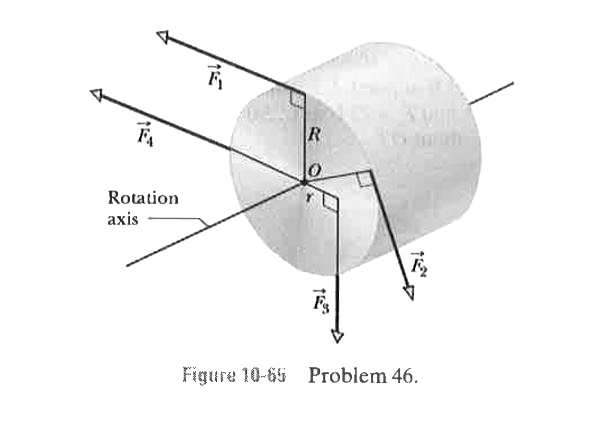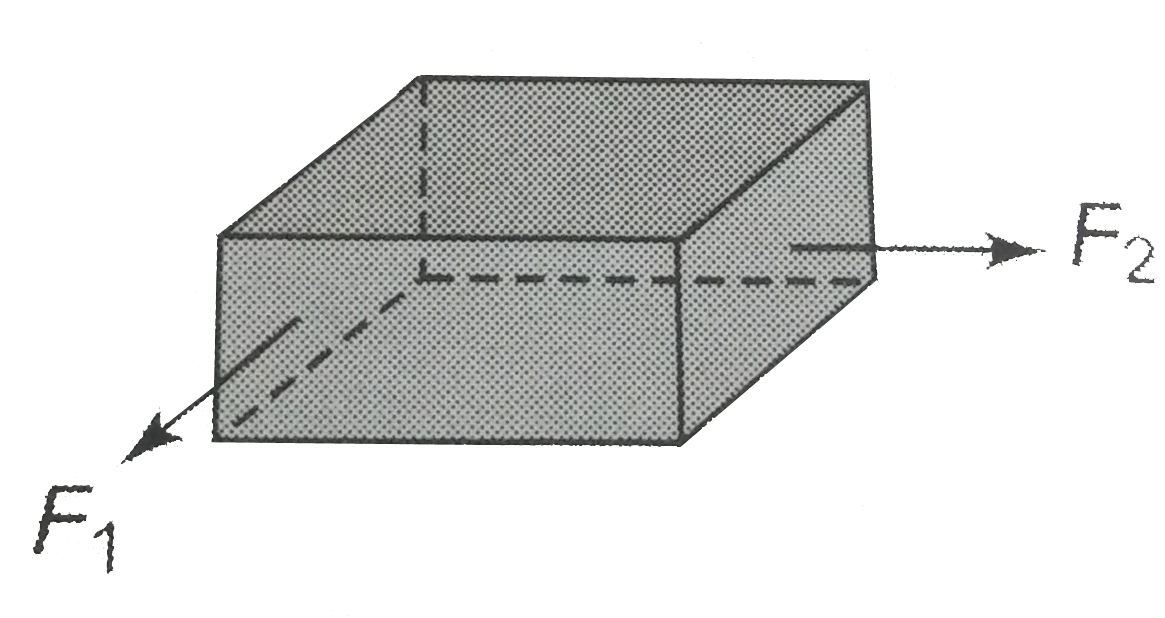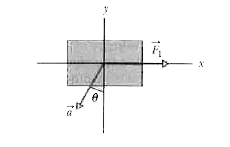In Fig. 10-65, a cylinder having a mass of 3.0 kg can rotate about its central axis through point O. Forces are applied as shown: F1=6.0N,F2=4.0N,F3=2.0NandF4=5.0N. Also, r = 5.0 cm and R = 12 cm. Find the (a) magnitude and (b) direction of the angular acceleration of the cylinder. (During the rotation, the forces maintain their same angles relative to the cylinder.)

(a) 6.5rad/s2, (b) The direction is counterclockwise (which is the positive sense of rotation).
Topper's Solved these Questions
- BOOK - RESNICK AND HALLIDAYCHAPTER - RIGID BODY DYNAMICS - IEXERCISE - PRACTICE QUESTIONS (SINGLE CORRECT CHOICE TYPE)43videos
RIGID BODY DYNAMICS - I
- BOOK - RESNICK AND HALLIDAYCHAPTER - RIGID BODY DYNAMICS - IEXERCISE - PRACTICE QUESTIONS (MORE THAN ONE CORRECT CHOICE TYPE)7videos
RIGID BODY DYNAMICS - I
- BOOK - RESNICK AND HALLIDAYCHAPTER - RIGID BODY DYNAMICS - IEXERCISE - CHECKPOINT18videos
RIGID BODY DYNAMICS - I
- BOOK - RESNICK AND HALLIDAYCHAPTER - RELATIVITYEXERCISE - PRACTICE QUESTIONS (Integer Type)5videos
RELATIVITY
- BOOK - RESNICK AND HALLIDAYCHAPTER - RIGID BODY DYNAMICS-IIEXERCISE - PRACTICE QUESTIONS (Integer Type)2videos
RIGID BODY DYNAMICS-II
Similar Questions
A uniform cylinder of radius 12 cm and mass 25 kg is mounted so as to rotate freely about a horizontal axis that is parallel to and 5.0 cm from the central longitudinal axis of the cylinder. (a) What is the rotational inertia of the cylinder about the axis of rotation? (b) If the cyliner is released from rest with its central longitudinal axis at the same height as the axis about which the cylinder rotates, what is the angular speed of the cylinder as it passes through its lowest position?
View SolutionA block of mass 8kg is kept on a rough floor. The coefficients of friction are μs=0.5 and μk=0.4. Force F1=15N and F2=20N are applied on the block as shown.
(a) Find the magnitude and the direction of friction force .
(b) If F1=30N,F2=40N, find the acceleration of the block.
 View Solution
View Solution
Knowledge Check
- Question 1 - Select One
A rope is wound round a hollow cylinder of mass 2 kg and radius 0.5 m. If the rope is pulled with a force of 80 N, the angular acceleration of the cylinder will be -
A20 rad/s2B40 rad/s2C60 rad/s2D80 rad/s2 - Question 2 - Select One
A solid cylinder of mass 20kg rotates about its axis with angular velocity of 100 radian s−1. The radius of the cylinder is 0.25m. The magnitude of the angular momentum of the cylinder about its axis of rotation is
A62.6 J sB70.4 J sC79.6 J sD60.5 J s - Question 3 - Select One
Two forces are applied to a 5.0 kg crate, one is 6.0N to the north and the other is 8.0N to the west. The magnitude of the acceleration of the crate is :
A0.50m/s2B2.0m/s2C2.8m/s2D10m/s2
A wheel of radius 10 cm can rotate freely about its centre as shown in figure. A stirng is wrapped over its rim and is ulle dby a force of 5.0 N. It is found that the torque roduces an angular acceleration 2.0 rads2 in the wheel. Calculate the moment of inertia of the wheel.
 View Solution
View SolutionThere are two forces on the 2.00 kg box in the overhead view of Fig. 5-38, but only one is shown. For F1=20.0N,a=12.0 m/s2, and θ=30.0∘, find the second force (a) in unit-vector notation and as (b) a magnitude and ( c ) an angle relative to the positive direction of the x axis.
 View Solution
View SolutionA rope of negligible mass is wound round. a hollow cylinder of mass 3kg and radius 40cm. What is angular acceleration (in rad / s2) of the cylinder if the rope is pulled with a force of 30N ? Assume that there is no slipping.
View SolutionStarting from rest, a disk rotates about its central axis with constant angular acceleration. In 5.0 s, it rotates 20 rad. During that time, what are the magnitudes of (a) the angular acceleration and (b) the average angular velocity? ( c) What is the instantaneous angular velocity of the disk at the end of the 5.0 s? (d) With the angular acceleration unchanged, through what additional angle will the disk turn during the next 5.0 s?
View SolutionA solid cylinder of mass 2 kg and radius 0.2m is rotating about its own axis without friction with angular velocity 3 rads/s. A particle of mass 0.5 kg and moving with a velocity 5 m/s strikes the cylinder and sticks to it as shown in figure. The angular momentum of the cylinder before collision will be?
 View Solution
View Solution

